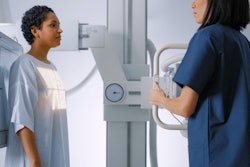
A community outreach program can be quite helpful in reducing racial disparity among women receiving breast cancer screening, according to a presentation at the recent Society of Breast Imaging/American College of Radiology symposium.
After adopting a number of outreach efforts, researchers from Penn Medicine found that their initiative yielded significant increases in the number of Asian and Hispanic women receiving breast cancer screening over a three-year period.
"Community outreach initiatives, partnerships with local organizations, reaching out, and providing effective translation services may be a potential strategy for increasing some of these patients," said presenter Dr. Meng Hao.
Increased utilization of screening mammography and improvement in treatments have lowered breast cancer mortality in the U.S. However, there continues to be racial disparity in breast cancer mortality, according to Hao.
According to census data from 2016, 42% of the population in Philadelphia are Black, 36% are white, 15% are Hispanic, and 7% are Asian. However, data from Pennsylvania Hospital in downtown Philadelphia showed that 59% of women receiving screening mammograms at their institution were white, 30% were Black, 4% were Asian, and 3% were Hispanic.
In an effort to reach more of these underrepresented populations, the hospital embarked on a community outreach program in 2017 to 2019, engaging with organizations in the area such as Project Home, the Imam Muslim Family Center, Puertes De Salud, Old Pine Community Center, Kleinlife, and the Vietnamese American Community Center. These activities included phone calls, visits, and disseminating information on American College of Radiology guidelines for breast cancer screening, as well as services -- digital breast tomosynthesis, MRI, and ultrasound -- provided at Pennsylvania Hospital.
"We're also working to improve translation services within the department," she said. "Whenever a patient presents whose English is not their primary language, our first primary strategy is to find on-site translation services for them. If that's not available, we have video translation."
In addition, they also increased the number of translated documents available for patients, as well as added more languages, such as Korean, Burmese, Vietnamese, and Mandarin.
"And we also encouraged incorporation of family if the patient was amenable to that," Hao said.
The outreach program led to a significant increase in the proportions of self-identified Asian and Hispanic patients receiving a screening mammogram at their hospital, according to the researchers.
| Increase in screening mammograms among racial groups following outreach program | |||
| 2016 | 2019 | Change | |
| Asian | 545 | 740 | 35.8%* |
| Hispanic | 532 | 702 | 32%* |
| Black | 4,769 | 5,253 | 10.1% |
| White | 9,249 | 9,827 | 6.2% |
The increases among Black and white patients did not reach statistical significance, however.
"Additional barriers exist and alternative and/or system-driven strategies may be needed to increase participation in screening mammograms, especially for the Black population," she said.
Hao noted that there may be some confounding factors for their results. There are numerous hospitals in the area, and it's possible that certain patient populations prefer different hospital sites.
The researchers are continuing to investigate this important topic, including assessing the impact of socioeconomic status on breast cancer screening. Looking into the future, growing utilization of supplemental screening such as breast ultrasound and MRI -- will pose further challenges, according to Hao.
"With a lot of these supplemental screenings, patients are going to have to pay out of pocket and that will just drive further disparities," she said. "I think it's important to really look at this data that we accrue over the years."




















